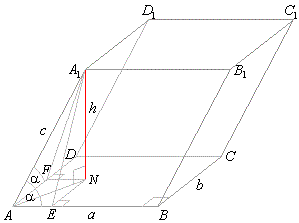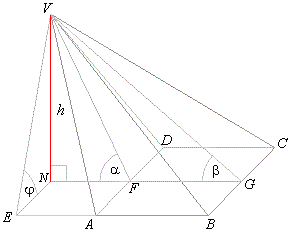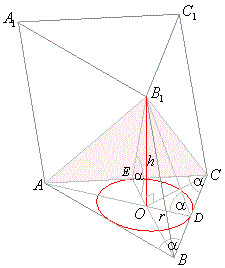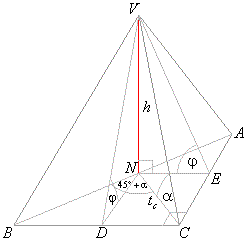|
| Applications
of Trigonometry |
|
 Applications
of Trigonometry in Solid Geometry
Applications
of Trigonometry in Solid Geometry |
 Oblique prism
Oblique prism |
 Oblique Pyramid
Oblique Pyramid |
|
|
|
|
|
|
|
|
|
|
Oblique prism
|
|
As an example of an oblique prism consider a parallelepiped whose lengths of the base edges and the lateral
edges sharing a common vertex are, a,
b and
c. Edges,
a and
b of bases, are perpendicular to each
while the lateral edge
c, forms the angle
a with each of them, see
the figure below.
other,
|
|
Determine the volume, the surface area of the
parallelepiped and the angle lateral edge to base.
|
| The volume
V =
B
· h =
a
· b
· h.
|
| The altitude of the parallelepiped is the intersection |
| line of
the planes, A1EN
and A1FN which are |
| perpendicular to the base
edges, a and
b and
thus to |
| the plane of base. |
| Created
triangles A1AE and A1AF
are congruent as |
| they share the hypotenuse and both have the same |
| angle a. |
| Thus,
A1E =
A1F
and therefore triangles, A1EN
and |
|
 |
|
|
A1FN
are congruent, so that EN =
FN. AN is the bisector of the right angle
DAB.
|

|
|
As by hypothesis, the base edges at the vertex
A
are perpendicular and the lateral edge c
forms equal
angles
a with the base edges, then must be
a > 45°, or
2a >
90°, and therefore, -
cos2a >
0.
|
|
Note that, if we follow changes (decrease) of the angle
a
while the height h tends to zero, finally, the end
points A1 and
N will coincide, and the lateral edge
c equals its
orthogonal projection AN (bisector of the
right angle, 2a =
90°).
|
| So the volume of the parallelepiped |
 |
|
|
Surface area S
= 2B + Slat. = 2ab + 2ac
· sina
+ 2bc
· sina
= 2
· [ab + c
· (a + b)
· sina].
|
|
Inclination of the lateral edge to base,
|
 |
|
|
|
|
Oblique Pyramid
|
|
As an example we consider the pyramid with square base. Two opposite faces are isosceles triangles one of
which forms with the base interior angle
b, and the other forms with the plane of the base an exterior angle
a.
The height of the pyramid is
h.
|
|
Determine the volume of the pyramid and angles that form two other lateral
faces with the plane of the base.
|
| The plane
VFG
(F and
G are midpoints of sides of |
| base) is
perpendicular to the plane of the base and |
| passes through the
height h of the pyramid. |
| Since a
is an exterior angle of the triangle VFG, the |
| foot N of the altitude
h falls at the extension of the |
| side
FG. |
| The
volume of the pyramid |
 |
|
 |
|

|
|
The angle of inclination of the lateral sides
VAB
and VCD
to the base we determine from the triangle
VEN
which is perpendicular to the plane of base, and whose leg is parallel with the edge
AD of the base, thus
|

|
|
|
|
Example: Bases of a triangular prism are isosceles triangles,
ABC
and
A1B1C1, with equal sides
AB = AC
and two equal angles
a. The normal projection of the vertex of the upper base falls at the center of
incircle of the radius r
of the lower base. Through the base edge AC
and the vertex B1
laid is a plane inclined to the lower base at angle
a. See
the figure below.
|
|
Determine the surface area of the pyramid
ABCB1
cut off from the prism and the volume of the prism.
|
| Solution:
The section plane
ACB1
cut off from the prism the |
| pyramid
ABCB1 the foot of
the height of which is at the center
|
| O of
incircle, so that all lateral
faces are inclined to the base |
| at
equal angles a. |
| Therefore,
we use the following formula for the surface area |
 |
 |
|
 |
|

|

|
|
|
|
Example:
Base of a pyramid is a right triangle. The pyramid’s altitude foot coincides with the intersection
point of the hypotenuse and the bisector of the right angle. The lateral edge at the right angle is inclined to
the base at an angle
a, see
the figure below. Determine volume of the pyramid and the lateral faces to base
dihedral angles if given is the right angle’s bisector
tc which with hypotenuse forms an angle of
45° + a.
|
| Solution: The
volume of the pyramid |
 |
|
In DNBC the
angle
BCN =
45°
|
| and
angle
NBC =
180°
-
[ 45° + a
+ 45°] =
90°
-
a,
|
| according to
the sine law
|
 |
|
 |
|

|
|
Triangles NEC
and NCD
are congruent. The lateral faces to base angles, NEV =
NDV =
j
.
|
|
They are the corresponding angles of two congruent triangles,
VNE
and VND.
|

|
|
|
|
|
|
|
|
|
|
|
|
|
|
|
|
|
|
|
| Geometry
and use of trigonometry contents - B |
|
|
 |
|
| Copyright
© 2004 - 2020, Nabla Ltd. All rights reserved. |